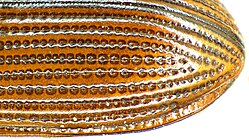Little Rotten Wood Beetle
| Little Rotten Wood Beetle | ||||||||||||
|---|---|---|---|---|---|---|---|---|---|---|---|---|

Small rotten wood beetle under pine bark |
||||||||||||
| Systematics | ||||||||||||
|
||||||||||||
| Scientific name | ||||||||||||
| Uloma Rufa | ||||||||||||
| ( Piller & Mitterpacher , 1783) |
The small rotten wood beetle , also Bergland kitchen beetle , ( Uloma rufa ) is a beetle from the family of the black beetle (Tenebrionidae). The genus Uloma is represented by five species in Europe; in Central Europe, apart from Uloma rufa, there is also the species Uloma culinaris . Synonym to Uloma rufa is Uloma perroudi Mulsant & Guillebeau needed. The beetle is listed in the Red List of Endangered Animals in Germany under category 2 (“highly endangered”).
The name “Kleiner Faulholz-Schwarzkäfer” is explained by the fact that it belongs to the black beetles named after their color, although the beetle is brownish-red, as the species name rufa ( Latin for “red”) expresses. The rotten wood beetle can be found in rotten wood and the addition “smaller” is explained by the fact that Uloma culinaris is slightly larger. The generic name Ulōma is from Old Gr . οὖλος "ōūlos" for "kraus" and ὦμος "ōmos" for "shoulder" derived.
Characteristics of the beetle
The elongated beetle with largely parallel sides reaches a length of eight to nine millimeters. It is hairless, shiny and strongly arched in cross section.
The relatively small head (Fig. 1) is much wider than it is long. In the male, in contrast to Uloma culinaris, the chin is inverted trapezoidal with upturned sharp front corners and not tomentose (Fig. 2, marked in green on the right). The end link of the jaw palpation is somewhat ax-shaped. The short, eleven-link, cord-shaped antennae are thick and thicken further towards the outside. The antennae root is covered by a lobed lateral extension of the cheeks. A shallow groove runs across the forehead between the eyes and ends behind the eyes (Fig. 1).
The dense and uniform dotted pronotum is much broader than the head. It is wider than it is long, the narrowest at the front, then it widens convexly at first, but soon hardly any more. It is clearly framed on the side. On the other hand, the weakly duplex base of the pronotum shows at most traces of a border (Fig. 3). In contrast to the uloma culinaris , the pronotum behind the head is not or at most only slightly indented and without small bumps in the male.
The elytra are clearly longitudinally streaked by rows of dots, but less prominent than in Uloma culinaris . The spaces between the dot stripes are flat and finely irregularly dotted (Fig. 4). The shoulder bumps are well developed.
The legs are strong. The outside of the front rails is closely serrated towards the rounded, enlarged tip (Fig. 5 V). On the upper side there is a distal notch (Fig. 5 V, black arrowhead) which enables the tarsus to be pushed back upwards. The middle rails are thorny on the outer edge (Fig. 5 M), the rear rails are almost smooth (Fig. 5 H). The family belongs to the heteromeric family group, so the tarsi are four-membered on the hind leg, otherwise five-membered. The hind tarsi, including the claw link, are finely bristled.
larva
The larvae of the genus Uloma (Fig. 6) are elongated. The pronotum is as long as the two following tergites combined. The legs are poorly developed. The last tergite of the abdomen is broadly rounded and ends in a small offset point.
biology
The forest-dwelling beetle can usually be found in rotten red-rotten softwood, especially in the stumps and roots of spruce and pine .
distribution
The beetle is widespread in northwestern Europe, in the south it is restricted to the mountains and their foreland. To the north it reaches Scandinavia and the northern parts of European Russia. To the south it can be found as far as Italy and isolated in Greece, but it is absent on the Iberian Peninsula and on the countries bordering the Adriatic Sea east of Italy as well as most Eastern European countries.
literature
- Heinz joy , Karl Wilhelm Harde , Gustav Adolf Lohse (ed.): The beetles of Central Europe . tape 8 . Teredilia Heteromera Lamellicornia . Elsevier, Spektrum, Akademischer Verlag, Munich 1969, ISBN 3-8274-0682-X .
- Klaus Koch : The Beetles of Central Europe Ecology . 1st edition. tape 2 . Goecke & Evers, Krefeld 1989, ISBN 3-87263-040-7 .
Individual evidence
- ^ A b Edmund Reitter : Fauna Germanica, the beetles of the German Empire III. Volume, KGLutz 'publishing house, Stuttgart 1911
- ↑ a b Uloma rufa at Fauna Europaea. Retrieved October 21, 2012
- ↑ Uloma at Fauna Europaea. Retrieved October 21, 2012
- ↑ Profile of ARGE SWD coleopterologists ( memento of the original from March 4, 2016 in the Internet Archive ) Info: The archive link was automatically inserted and not yet checked. Please check the original and archive link according to the instructions and then remove this notice.
- ↑ Red Lists of Bionetworx
- ↑ Sigmund Schenkling: Explanation of the scientific beetle names (species)
- ↑ Sigmund Schenkling: Explanation of the scientific beetle names (genus)
- ↑ Klaus Koch : Die Käfer Mitteleuropas Ökologie . 1st edition. tape 2 . Goecke & Evers, Krefeld 1989, ISBN 3-87263-040-7 .





